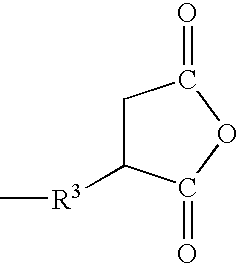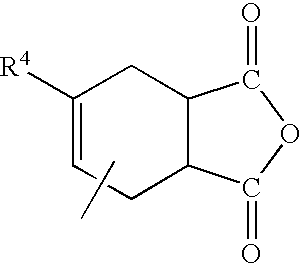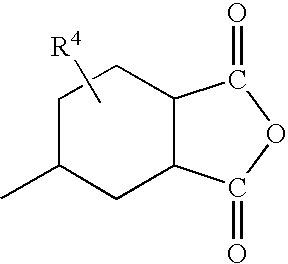Organopolysiloxane-modified polysaccharide and process for producing the same
a technology of organopolysiloxane and polysaccharide, which is applied in the field of organopolysiloxanemodified polysaccharides, can solve the problems of low ratio of organopolysiloxane introduced into the polysaccharides, and low reactivity between the starting organopolysiloxane and the polysaccharides
- Summary
- Abstract
- Description
- Claims
- Application Information
AI Technical Summary
Benefits of technology
Problems solved by technology
Method used
Image
Examples
reference example 1
[0031] A complex of platinum and 1,3-divinyltetramethyldisiloxane (an amount sufficient to provide 5 ppm of platinum metal relative to the total weight of the reaction starting materials) was added to 25 g of dimethylpolysiloxane represented by the formula:
(silicon-bonded hydrogen atoms=24.1 millimol) under a nitrogen atmosphere, the mixture was heated to 80° C. and 3.38 g (24.1 millimol) of allylsuccinic anhydride were added thereto in a dropwise manner. Upon termination of the dropwise addition, the mixture was stirred for 5 hours at a temperature within the range of from 80° C. to 100° C. Subsequently, 27.2 g of a polymer were obtained by eluting low-boiling fractions by heating under reduced pressure. A nuclear magnetic resonance analysis (referred to as NMR below) and infrared spectroscopy analysis (referred to as IR below) of the polymer found that it was a dimethylpolysiloxane represented by the formula:
reference example 2
[0032] A complex of platinum and 1,3-divinyltetramethyldisiloxane (an amount sufficient to provide 5 ppm of platinum metal relative to the total weight of the reaction starting materials) was added to 25 g of dimethylpolysiloxane represented by the formula:
(silicon-bonded hydrogen atoms=30.5 millimol) under a nitrogen atmosphere, the mixture was heated to 80° C. and 3.38 g (30.5 millimol) of allylsuccinic anhydride were added thereto in a dropwise manner. Upon termination of the dropwise addition, the mixture was stirred for 5 hours at a temperature within the range of from 80° C. to 100° C. Subsequently, 27.2 g of a polymer were obtained by eluting low-boiling fractions by heating under reduced pressure. An NMR and IR analysis of the polymer found that it was a dimethylpolysiloxane represented by the formula:
reference example 3
[0033] A complex of platinum and 1,3-divinyltetramethyldisiloxane (an amount sufficient to provide 5 ppm of platinum metal relative to the total weight of the reaction starting materials) was added to 2.23 g of 2-methyl-3-butyn-2-ol (26.5 millimol) under a nitrogen atmosphere, the mixture was heated to 100° C. and 25 g (silicon-bonded hydrogen atoms=24.1 millimol) of dimethylpolysiloxane represented by the formula:
were added thereto in a dropwise manner. Upon termination of the dropwise addition, the mixture was stirred for 1.5 hours at 110° C., whereupon it was determined by an IR analysis that the absorption of the silicon-bonded hydrogen atoms had disappeared. Subsequently, excess 2-methyl-3-butyn-2-ol and other low-boiling fractions were eluted by heating under reduced pressure, yielding 26.1 g of polymer. An NMR and IR analysis of the polymer found that it was a dimethylpolysiloxane mixture made up of a dimethylpolysiloxane represented by the formula:
and a dimethylpolysil...
PUM
| Property | Measurement | Unit |
|---|---|---|
| reaction temperature | aaaaa | aaaaa |
| reaction temperature | aaaaa | aaaaa |
| weight | aaaaa | aaaaa |
Abstract
Description
Claims
Application Information
 Login to View More
Login to View More - R&D
- Intellectual Property
- Life Sciences
- Materials
- Tech Scout
- Unparalleled Data Quality
- Higher Quality Content
- 60% Fewer Hallucinations
Browse by: Latest US Patents, China's latest patents, Technical Efficacy Thesaurus, Application Domain, Technology Topic, Popular Technical Reports.
© 2025 PatSnap. All rights reserved.Legal|Privacy policy|Modern Slavery Act Transparency Statement|Sitemap|About US| Contact US: help@patsnap.com



